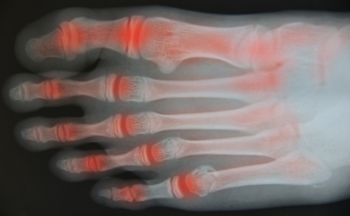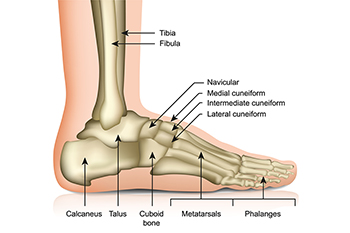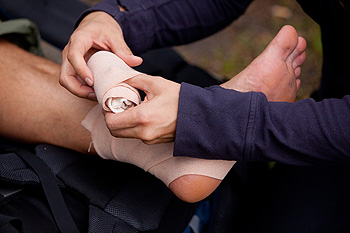April 2023
Can Walking Help Arthritis in the Feet?

Research has shown that walking is one of the best low-impact activities that can help people who have arthritis in their feet. This condition can affect people of all ages, and it may be more prevalent among the elderly. Walking can also be beneficial for overall physical health, and many patients notice the positive feeling that is associated with walking. There are three main categories of arthritis, and these are referred to as osteo, rheumatoid, and post-traumatic arthritis. Walking can strengthen the bones in the feet, and stress on the joints may be reduced. It is beneficial to start out slowly, and steps can be increased as time progresses. Patients who have arthritis in their feet may reap the benefits of walking by stretching first, drinking plenty of water, and wearing shoes that fit correctly. Additionally, the range of motion in the ankle may be improved when specific stretches are performed. If you would like more information about how walking may help arthritis in the feet, it is suggested that you consult with a podiatrist who can help you manage this painful condition.
Arthritis can be a difficult condition to live with. If you are seeking treatment, contact Corinne R. Kauderer, DPM from Dyker Heights Foot & Ankle. Our doctor can provide the care you need to keep you pain-free and on your feet.
Arthritic Foot Care
Arthritis is a term that is commonly used to describe joint pain. The condition itself can occur to anyone of any age, race, or gender, and there are over 100 types of it. Nevertheless, arthritis is more commonly found in women compared to men, and it is also more prevalent in those who are overweight. The causes of arthritis vary depending on which type of arthritis you have. Osteoarthritis for example, is often caused by injury, while rheumatoid arthritis is caused by a misdirected immune system.
Symptoms
- Swelling
- Pain
- Stiffness
- Decreased Range of Motion
Arthritic symptoms range in severity, and they may come and go. Some symptoms stay the same for several years but could potentially get worse with time. Severe cases of arthritis can prevent its sufferers from performing daily activities and make walking difficult.
Risk Factors
- Occupation – Occupations requiring repetitive knee movements have been linked to osteoarthritis
- Obesity – Excess weight can contribute to osteoarthritis development
- Infection – Microbial agents can infect the joints and trigger arthritis
- Joint Injuries – Damage to joints may lead to osteoarthritis
- Age – Risk increases with age
- Gender –Most types are more common in women
- Genetics – Arthritis can be hereditary
If you suspect your arthritis is affecting your feet, it is crucial that you see a podiatrist immediately. Your doctor will be able to address your specific case and help you decide which treatment method is best for you.
If you have any questions, please feel free to contact one of our offices located in Brooklyn, NY and Old Bridge, NJ . We offer the newest diagnostic and treatment technologies for all your foot care needs.
The Many Facets of the Foot

There are many moving parts each foot is made of. There are 26 bones along with several joints, tendons, and muscles that work together that enable the body to walk, run, and balance. Approximately one-quarter of all the bones that are in the body are located in the feet. Each toe has three joints, and the big toe has two joints. The calcaneus is considered to be the largest bone in the foot, and it forms the heel bone. The muscles provide the ability to move the feet, and each group of muscles provides a different function. The largest ligament in the foot is known as the plantar fascia, and it connects the heel to the toes. The Achilles tendon has the ability to provide mobility to the foot, and if an injury happens to this tendon, walking is often impaired. If you would like additional information about various components of the foot, it is suggested that you consult with a podiatrist who can give you interesting and useful knowledge.
If you have any concerns about your feet, contact Corinne R. Kauderer, DPM from Dyker Heights Foot & Ankle. Our doctor can provide the care you need to keep you pain-free and on your feet.
Biomechanics in Podiatry
Podiatric biomechanics is a particular sector of specialty podiatry with licensed practitioners who are trained to diagnose and treat conditions affecting the foot, ankle and lower leg. Biomechanics deals with the forces that act against the body, causing an interference with the biological structures. It focuses on the movement of the ankle, the foot and the forces that interact with them.
A History of Biomechanics
- Biomechanics dates back to the BC era in Egypt where evidence of professional foot care has been recorded.
- In 1974, biomechanics gained a higher profile from the studies of Merton Root, who claimed that by changing or controlling the forces between the ankle and the foot, corrections or conditions could be implemented to gain strength and coordination in the area.
Modern technological improvements are based on past theories and therapeutic processes that provide a better understanding of podiatric concepts for biomechanics. Computers can provide accurate information about the forces and patterns of the feet and lower legs.
Understanding biomechanics of the feet can help improve and eliminate pain, stopping further stress to the foot.
If you have any questions please feel free to contact one of our offices located in Brooklyn, NY and Old Bridge, NJ . We offer the newest diagnostic and treatment technologies for all your foot and ankle needs.
Trampoline Ankle Fracture in Kids

“Trampoline ankle” or a Saltar Harris fracture is a rare type of ankle fracture that happens when two or more people are bouncing out of sync on a trampoline. The resulting kinetic energy causes a high-impact effect that can a cause serious growth plate injury in a child. In this type of injury, the problem involves the growth plate, which is why it is unique to children and not adults. This type of fracture occurs when the trampoline bed is ascending and the child who sustains the injury is on the descent. The growth plate is an area of cartilage that is actively developing into new bone. The tibia bone of the leg stops growing generally around the ages of 14 to 18. If this fracture is not tended to, it can lead to permanent bone growth arrest. If your child has sustained an ankle fracture while on the trampoline, it is suggested that you visit a podiatrist as soon as possible for diagnosis and treatment.
Ankle and foot injuries are common among athletes and in many sports. They can be caused by several problems and may be potentially serious. If you are feeling pain or think you were injured in a sporting event or when exercising, consult with Corinne R. Kauderer, DPM from Dyker Heights Foot & Ankle. Our doctor will assess your condition and provide you with quality foot and ankle treatment.
Common Injuries
The most common injuries that occur in sporting activities include:
- Achilles Tendonitis
- Achilles Tendon Rupture
- Ankle Sprains
- Broken Foot
- Plantar Fasciitis
- Stress Fractures
- Turf Toe
Symptoms
Symptoms vary depending upon the injury and in some cases, there may be no symptoms at all. However, in most cases, some form of symptom is experienced. Pain, aching, burning, bruising, tenderness, tightness or stiffness, sensation loss, difficulty moving, and swelling are the most common symptoms.
Treatment
Just as symptoms vary depending upon the injury, so do treatment options. A common treatment method is known as the RICE method. This method involves rest, applying ice, compression and elevating the afflicted foot or ankle. If the injury appears to be more serious, surgery might be required, such as arthroscopic or reconstructive surgery. Lastly, rehabilitation or therapy might be needed to gain full functionality in the afflicted area. Any discomfort experienced by an athlete must be evaluated by a licensed, reputable medical professional.
If you have any questions, please feel free to contact one of our offices located in Brooklyn, NY and Old Bridge, NJ . We offer the newest diagnostic and treatment technologies for all your foot care needs.
Do Your Child's Feet Hurt?
Flexible and Rigid Hammertoe

Hammertoe is an ailment that affects the toes in the feet. Specifically, the second, third or fourth toes are targeted with this condition and this can happen due to genetics. Patients who have this ailment notice their toes bend downward, and can resemble a hammer. It may also develop from wearing shoes that do not have ample room for the toes to move freely in. This may cause a muscle imbalance, and common symptoms can include swelling and pain, and it can be difficult to walk. This condition develops gradually, and the toes are flexible when first noticed. Prompt medical treatment is necessary to prevent the toes from becoming rigid, because at that point treatment may be difficult. Patients can find mild relief when different shoes are worn, preferably with a low heel and plenty of room that can accommodate the toes. This can be followed by practicing specific exercises that can strengthen the toes. If you have developed hammertoe, it is suggested that you speak with a podiatrist who can guide you toward the treatment method that is right for you.
Hammertoes can be a painful condition to live with. For more information, contact Corinne R. Kauderer, DPM of Dyker Heights Foot & Ankle. Our doctor will answer any of your foot- and ankle-related questions.
Hammertoe
Hammertoe is a foot deformity that occurs due to an imbalance in the muscles, tendons, or ligaments that normally hold the toe straight. It can be caused by the type of shoes you wear, your foot structure, trauma, and certain disease processes.
Symptoms
- Painful and/or difficult toe movement
- Swelling
- Joint stiffness
- Calluses/Corns
- Physical deformity
Risk Factors
- Age – The risk of hammertoe increases with age
- Sex – Women are more likely to have hammertoe compared to men
- Toe Length – You are more likely to develop hammertoe if your second toe is longer than your big toe
- Certain Diseases – Arthritis and diabetes may make you more likely to develop hammertoe
Treatment
If you have hammertoe, you should change into a more comfortable shoe that provides enough room for your toes. Exercises such as picking up marbles may strengthen and stretch your toe muscles. Nevertheless, it is important to seek assistance from a podiatrist in order to determine the severity of your hammertoe and see which treatment option will work best for you.
If you have any questions, please feel free to contact one of our offices located in Brooklyn, NY and Old Bridge, NJ . We offer the newest diagnostic and treatment technologies for all your foot care needs.








